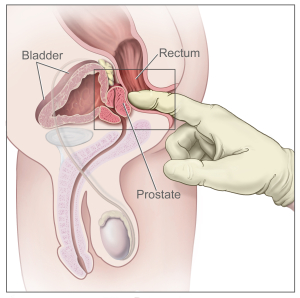There are many symptoms that may be a sign of prostate problems.
- Having to get up in the night to urinate
- Having to urinate suddenly and urgently
- Trouble starting to urinate
- Slow urine flow
- Trouble stopping urination (dribbling)
- Discomfort when urinating
- Painful ejaculation
- Blood in your urine or semen
- Low sex drive
- Trouble getting or keeping an erection
The trouble is, quite a few of these symptoms can occur as part of aging and men seem to expect them. Nevertheless, if you are experiencing any of them, go to your GP and get checked out.
Also, there are many occasions where a prostate problem is present with none of these symptoms. Therefore, regular prostate testing is recommended.
Prostate Specific Antigen (PSA) test
There is a simple blood test that measures a particular chemical called PSA. It has been shown that raised levels of this chemical are a good indicator of prostate cancer. Unfortunately, other factors can also raise the level of PSA, so we do tend to get some “false positives”, that is, a high level when there is no problem or cancer.
So if you have had a PSA test and it has come back with a scary result, my first piece of advice is DON’T PANIC!
My second piece of advice is DON’T IGNORE IT! Any abnormal PSA result should be followed up.
If you have any concerns about your PSA result, then feel free to go to my contact site and let me know of your concerns.
Prostate exam

Digital rectal exam: side view of the male reproductive and urinary anatomy, including the prostate, rectum, and bladder.
Image from Wikipedia
You should definitely go for a follow-up prostate exam. This is a quite simple test where the doctor will put a (well-lubricated and gloved) finger in your rectum so they can feel the prostate. See the diagram.
The doctor will feel for any lumps or hardening of the prostate. The drawback is that the doctor can only feel part of the prostate touching the rectum and so could miss a potential problem in the anterior part of the prostate gland that can not be reached or felt.
If the follow-up tests reveal a problem or if your doctor is still worried, call my secretary or head to our appointments page to make a time to see me.
When a prostate cancer is small it is usually not palpable. So if your prostate blood test (PSA) is high, then don’t ignore it, even if the prostate examination feels OK.
Biopsy
We take a biopsy by putting a ultrasound probe needle into the rectum. Using the images from the ultrasound to guide us, we pass a number of small needles into the prostate. Each needle retrieves a small sample of tissue from the prostate that we can perform tests on. The needles are inserted into the prostate via the rectum, or the perineum (between the anus and scrotal sac).
The biopsy will show us if the tissue of the prostate is normal, pre-cancerous or cancerous.
MRI Scan
Improved technology in MRI imaging has made it much more accurate to see cancer on an MRI scan. The MRI scan can be performed before the biopsy to help me find any suspicious areas in the prostate. This has been shown to improve the accuracy of diagnosing a prostate cancer. I can directly target areas in the prostate that are shown to be abnormal on the MRI, which can improve the chance of finding any cancer in your prostate.
One last thing
A lot of men put off getting tested for prostate problems because of the sensitive nature of the testing and treatment.
You need to get past that. Prostate cancer kills more than 3000 men in Australia every year. The initial testing is simple and relatively painless (ask your wife what a mammogram feels like) and the PSA test is covered by Medicare. A study by the Prostate Cancer Foundation of Australia found that only 6% of men described the test as painful or embarrassing.
If you are over 50 and you have not has a test for prostate cancer, get to your GP. If you have any history of prostate disease in your family, make that 40.
The Urological Society of Australia and New Zealand now recommends that you go to your doctor at the age of 40 to discuss your risk of prostate cancer. If the PSA blood test at this age is very low (<0.8) then you have a low chance of developing prostate cancer in the following 20 years. But if your test is above the middle range for your age, then close follow up will be required.

